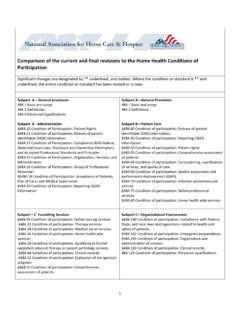Transcription of World Health Organization Health Systems Strengthening ...
1 World Health Organization Health Systems Strengthening glossary Access (to Health services): the perceptions and experiences of people as to their ease in reaching Health services or Health facilities in terms of location, time, and ease of (of Health services): aspects of the structure of Health services or Health facilities that enhance the ability of people to reach a Health care practitioner, in terms of location, time, and ease of : the result of the process which ensures that Health actors take responsibility of what they are obliged to do and are made answerable for their actions. Accreditation: "accreditation is a formal process by which a recognized body, usually a non governmental Organization , assesses and recognizes that a Health care Organization meets applicable pre determined and published standards.
2 Accreditation standards are usually regarded as optimal and achievable, and are designed to encourage continuous improvement efforts within accredited organizations. An accreditation decision about a specific Health care Organization is made following a periodic on site evaluation by a team of peer reviewers, typically conducted every two to three years. Accreditation is often a voluntary process in which organizations choose to participate, rather than one required by law and regulation."3 Accuracy: "the degree to which a measurement or an estimate based on measurements represents the true value of the attribute that is being measured."4 Aid effectiveness: effectiveness of development aid in achieving economic or human development or development According to the Paris Declaration on Aid Effectiveness (see below) five principles are key to improved aid effectiveness: Ownership (partner countries exercise effective leadership over their development policies, and strategies and coordinate development actions); Alignment (donors base their overall support on partner countries' national development strategies, institutions and procedures); Harmonization (donors' actions are more harmonized, transparent and collectively effective).
3 Managing for results (partner countries and donors shift focus to development results and results get measured); and Mutual Accountability (donors, partners and countries are accountable for development results). 6 See Paris Declaration. Aid: (i) support provided by countries, international agencies, institutions, non governmental organizations or foundations, to developing countries in the form of monetary grants, loans at low interest rates, in kind, or a combination of (ii) shorthand for Overseas Development Aid , resource flows which qualify as Official Development Assistance or Official Aid according to criteria used by institutions such as the in kind: "flows of goods and services with no payment in money or debt instruments in exchange.
4 In some cases, 'commodity aid' goods (such as grain) are subsequently sold and the receipts are used in the budget or, more commonly through a special fund, for public expenditure."9 Alignment: the result of donors basing their support on the country's national development strategies, institutions and processes to increase development assistance coherence, synergy and effectiveness . See Paris declaration. Allocative efficiency: (i) the extent of optimality in distribution of resources among a number of competing uses;10 (ii) the capacity of a system to distribute resources among competing activities, in a way that no alternative reallocation offers improvements in returns. Related to the comparative efficacy of interventions and to priority setting; (iii) an aggregate concept, referring to competing options, inside or outside the Health sector, and to the scale of programmes.
5 Allocative efficiency assumes that competing options work at the same level of technical efficiency. Appropriate care: (i) care that meets the Health needs of the entire population; (ii) care that is effective and based on the best available scientific evidence; (iii) interventions that are safe and that do not cause any harm or suffering; and priorities for the allocation and Organization of resources that are based on equity and economic Assessment: a formal process of evaluation of a process or system , preferably quantitative, but sometimes necessarily qualitative. 12 Audit: "the legal requirement for a corporation to have its balance sheet, financial statement, and underlying accounting system and records examined by a qualified auditor so as to enable an opinion to be formed as to whether the financial statement accurately represent the company's financial condition and whether they comply with relevant statutes.
6 " Balance (within a national Health policy/strategy/plan): the extent to which the level of detail of the different components of the NHPSP and the weight given to different priorities provides due and proportional attention to the different priorities identified by the country. Benchmark: (i) a measurement or point of reference at the beginning of an activity which is used for comparison with subsequent measurements of the same variable; (ii) unacceptable standard in of Integration: Number of different functions and services provided along the continuum of Support: (i) direct budget support is defined as a method of financing a partner country's budget through a transfer of resources from an external financing agency to the partner government's national treasury.
7 The funds thus transferred are managed in accordance with the recipient's budgetary procedures. Funds transferred to the national treasury for financing programmes or projects managed according to different budgetary procedures from those of the partner country, with the intention of earmarking the resources for specific uses, are not part of direct budget support. (ii) General budget support: a subcategory of direct budget support focusing on overall policy and budget priorities. (iii) Sector budget support: a subcategory of direct budget support co funding the national budget of a particular sector. The support is thus nominally earmarked, for the sector and used according to the national public expenditure management rules and 16 Budgeting: the process of elaborating a detailed plan for the future showing how resources will be acquired and used during a specific time period, expressed in formal, measurable 2 Burden of disease: a measurement of the gap between current Health status and an ideal situation where everyone lives into old age, free of disease and See Global Burden of Disease.
8 Capital expenditure: the cost for resources that last more than one year, such as building, vehicles, computers, pre service training. Sometime a price ceiling is also defined (usually $US 100), below which costs are considered as recurrent. The cost of capital equipment is net of depreciation. Also called investment or non recurrent Care Maps: plans for the management of patient care that set goals for patients and provide the sequence of interventions that physicians, nurses and other professionals should carry out in order to reach the desired goals in a given time Case Management: provision of continuous care across different services through the integration and coordination of needs and resources around the patient.
9 The fundamental difference with disease management is that it focuses more on individual patients and their families than on the population of patients with a certain disease. This type of management is targeted at people with a high level of risk requiring expensive care, people who are vulnerable, or have complex social and Health needs. The case manager coordinates patient care throughout the entire continuum of Certification: a process by which an authorized body, either a governmental or non governmental Organization , evaluates and recognizes either an individual or an Organization as meeting pre determined requirements or criteria. Although the terms accreditation and certification are often used interchangeably, accreditation usually applies only to organizations, while certification may apply to individuals, as well as to organizations.
10 When applied to individual practitioners, certification usually implies that the individual has received additional education and training, and demonstrated competence in a specialty area beyond the minimum requirements set for licensure. An example of such a certification process is a physician who receives certification by a professional specialty board in the practice of obstetrics. When applied to an Organization , or part of an Organization , such as the laboratory, certification usually implies that the Organization has additional services, technology, or capacity beyond those found in similar Integration: the extent to which patient care is coordinated across the system s different functions, activities and operating units.
















